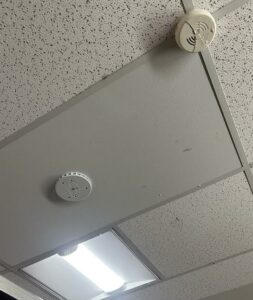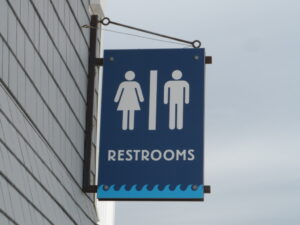Chris Herren is a former professional basketball player and current voice on the topic of substance use prevention and wellness advocate. Since 2009, Chris has spoken to over two million students, athletes and community members, sparking honest discussions on the topic of substance use disorder. He was recently invited to visit Bedford High School prompted by the growing use of drugs, tobacco products, and alcohol in the community. The Drug Counselor here at BHS, Jess Bennett, scheduled the assembly and booked Chris Herren. During an interview with Ms. Bennett, she indicated drug abuse at the school lies in two separate realms: those who get caught with a substance on them and those who come in willingly struggling with their own substance use. She also stated the most common drugs being used by BHS students are THC and Nicotine products.
Bedford High students are not alone. With approximately 11% of 12th-grade students across the United States reporting past-year use of delta-8- tetrahydrocannabinol (delta-8-THC, or delta-8 for short), according to an analysis of data from the 2023 Monitoring the Future survey, which is funded by the National Institutes of Health. One in ten members of the senior class are at risk of falling victim to THC. This threat could also exacerbate the growing risk of BHS students to experience depression associated with the school’s demanding workload and the high academic expectations of the Bedford community as a whole.
Mrs. Bennet affirms the concern that many BHS students are using drugs as a coping mechanism. Potentially attempting to use the drugs as a way to deal with the stress of BHS academics. Unintentionally worsening their mental health as THC (Weed) is associated with an increased risk of developing or worsening disorders related to anxiety and depression. Paired with the proven addictive nicotine, BHS students are at serious risk of jeopardizing their wellness.
(Chris Herren Speaking to High School Students)
In the BHS school system, Mrs. Bennet warns of the increasing rate in which students are turning to drugs at younger and younger ages saying it is starting as early as 5th or 6th grade.
Learning these statistics leads to the question of how students are gaining access to these illegal drugs and using them without getting caught? 88% to 95% of teens (age 13 to 18) have their own smartphone (Rideout et al., 2022; Pew 2022). There is one obvious way here at our school. The fact of the matter is the usage of cell phones at Bedford High School is such an issue that it is now school policy that students hand them over to their teacher during class putting them in specific holders. What does this have to do with drugs? When students have access to the internet, they also have access to a free app, Snapchat. Snapchat messages, or snaps, are deleted once they’re viewed by the recipient, making it difficult to report illicit activity to authorities or to Snap Inc., which owns the app. The app also alerts people when a screenshot is taken of their messages. In countless cases drug dealers are utilizing this function to hide transactions with minors in which they discuss payment, and a location for drop off. Often having code words in their username allowing students to identify them or slang words such as “roids” or “sugar”. Today’s chronically online generation using this new method poses a threat to parents and caretakers in which messages are easy to hide. While many students at BHS utilize this method the hiding of drugs is much more dirty, disposing of nicotine products such as Zyn in the urinal.
Since the early 2000s, cigarettes first hit the shelves, but vaping has now become a major issue. Adolescent use of e-cigarettes has increased by 1000% since 2020, and according to the FDA, 14.1% (2.14 million) of high school students reported using e-cigarettes in 2022. In the Bedford school system this has been addressed through implementation of vape detectors in the school bathrooms, a bid to school parent that the school board is concerned for the dangers posed towards students.

(Photo of vape detectors Boys Bathroom)
If you or any of your friends are in need of help Bulldog unleashed would urges you to reach out to BHS’s highly qualified counselors or call the national teen drug helpline (844)-289-0879.
Work Cited
Abuse, National Institute on Drug. “Delta-8-THC Use Reported by 11% of 12th Graders in 2023 | National Institute on Drug Abuse (NIDA).” Nida.nih.gov, 12 Mar. 2024, nida.nih.gov/news-events/news-releases/2024/03/delta-8-thc-use-reported-by-11-of-12th-graders-in-2023.
“Dynamics of Social Media Drug Markets.” PopNAD, nordicwelfare.org/popnad/en/artiklar/dynamics-of-social-media-drug-markets/.
—.“Home.” Herren Talks, herrentalks.com/.
Keller, Amy. “How Do Teens Get Drugs.” Drug Rehab, 2014, www.drugrehab.com/teens/how-teens-get-drugs/.
Merrill, Dr Jennifer. “Teen Drug Abuse Hotline | Call Our Teen Drug Hotline Today for Help.” National Drug Helpline, drughelpline.org/teens/.
Poe, Drake. “Detectors Are Not the Answer: Whitman Needs More Effective Vape-Prevention Strategies.” The Black and White, theblackandwhite.net/75483/opinion/detectors-are-not-the-answer-whitman-needs-more-effective-vape-prevention-strategies/.
Radesky, Jenny, et al. Constant Companion: A Week in the Life of a Young Person’s Smartphone Use. Common Sense, 2023.





